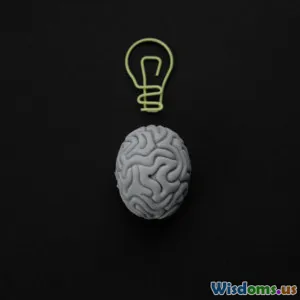
The Psychology of Nightmares
8 min read Explore the science of nightmares, uncovering their causes, effects, and what they reveal about our minds. (0 Reviews)
The Psychology of Nightmares: Unlocking the Secrets of Troubling Dreams
Nightmares can feel like a haunting, otherworldly experience that lingers long after waking. Those terrifying visions in our sleep mystify researchers and sufferers alike. But are nightmares merely random, scary movies our minds conjure, or do they serve a deeper psychological purpose? In this article, we explore the psychology and brain science behind nightmares, shining light on why our brains fabricate such distressing dreams and how understanding them can improve mental health.
What Are Nightmares? Definition and Prevalence
Nightmares are vivid, disturbing dreams that often awaken the sleeper and cause intense feelings of fear, anxiety, or sadness. Unlike simply unpleasant dreams, nightmares typically involve threats to survival or security like chasing, falling, or harm to loved ones—triggering strong emotional reactions.
Studies suggest that about 5% of adults suffer from frequent nightmares, while up to 50-85% may experience occasional nightmares during their lives (Nielsen & Levin, 2007). Children are even more prone; over 50% report nightmares that disrupt sleep or cause distress. Nightmares are also associated with psychological distress, trauma, and certain sleep disorders.
The Brain Behind Nightmares: A Neuroscientific View
The Limbic System and Emotional Processing
The limbic system, particularly the amygdala and hippocampus, plays a central role in generating nightmares. The amygdala processes fear and threats, often making distressing scenarios vivid. In REM (rapid eye movement) sleep, when most dreaming occurs, the amygdala is highly active, allowing dreams with intense emotional quality to emerge.
The hippocampus, responsible for memory consolidation, helps integrate emotional memories in dreams. If stressful or traumatic events become stored in a hyperactive, fragmented way, nightmares may arise during REM to help process that trauma.
Prefrontal Cortex Inhibition
Normally, the prefrontal cortex—a region linked with logical reasoning and moderation of emotions—is less active during REM sleep. This reduced activity diminishes our critical thinking and reality testing in dreams, allowing bizarre or frightening scenarios to unfold unchallenged, leading to nightmares.
Neurochemical Influences
Neurotransmitters like serotonin, norepinephrine, and dopamine regulate mood and sleep architecture. Imbalances, often found in people with depression or PTSD, may predispose someone to nightmares by disrupting normal REM sleep and emotional regulation.
Psychological Perspectives on Nightmares
Nightmares as Emotional Processing
Many psychologists view nightmares as a mental mechanism to process difficult emotions or traumatic memories safely. According to the Threat Simulation Theory (Revonsuo, 2000), nightmares simulate threatening experiences allowing the brain to rehearse coping strategies in a safe environment.
Trauma and PTSD
A direct link exists between trauma and frequent nightmares. Around 70% of people with Post-Traumatic Stress Disorder (PTSD) report persistent nightmares replicating or symbolizing their trauma (Nazarov et al., 2018). Nightmares here function as repeated re-experiencing of trauma, often causing sleep disruption and heightened anxiety.
Anxiety, Stress, and Depression
Beyond trauma, generalized anxiety or depression can exacerbate nightmare frequency. Chronic stress alters cortisol levels, impacting sleep quality. People with mood disorders often have fragmented REM sleep, facilitating disturbed dreaming.
Nightmares’ Impact on Well-Being
Sleep Disruption and Daytime Functioning
Nightmares that awaken the sleeper can induce fragmented sleep, leading to daytime fatigue, impaired cognition, and reduced emotional resilience. Over time, poor sleep perpetuates a vicious cycle of anxiety and further nightmares.
Emotional Toll and Avoidance
Chronic nightmares cause intense fear of sleep, sometimes evolving into sleep avoidance behaviors and insomnia. The emotional burden also includes feelings of helplessness and a decline in quality of life.
Managing and Interpreting Nightmares
Evidence-Based Treatments
-
Imagery Rehearsal Therapy (IRT): A proven cognitive-behavioral treatment where patients consciously reimagine their nightmares with altered, non-threatening endings. Multiple studies show IRT significantly reduces nightmare frequency and distress.
-
Exposure, Relaxation, and Rescripting Therapy (ERRT): Combines exposure to nightmare content with relaxation techniques and rescripting for improved coping.
-
Medication: Prazosin, an alpha-blocker, reduces nightmare severity in PTSD by lowering central nervous system norepinephrine.
Self-Help Strategies
-
Keeping a dream journal to recognize recurring themes and triggers.
-
Improving sleep hygiene: consistent sleep schedules, reducing screen time before bed, and creating a calming bedtime routine.
-
Practicing mindfulness and relaxation to reduce daytime stress.
What Nightmares Can Tell Us
While terrifying, nightmares often provide a window into our subconscious fears and unresolved emotional conflicts. Paying attention to nightmare content can aid self-reflection and identify areas needing psychological care.
Real-World Example: Nightmare Research in Veterans
A 2019 study examined Vietnam War veterans with PTSD and found persistent nightmares were linked to increased amygdala activation and disrupted hippocampal connectivity during sleep. Veterans receiving IRT showed a 60% reduction in nightmares and improved quality of life after 12 weeks (Krakow et al., 2019). This highlights how integrating neuroscience and psychology leads to successful nightmare interventions.
Conclusion: From Fear to Healing
Nightmares remain one of the most visceral connections between brain science and the mystery of dreams. Far from mere nocturnal fright, they reflect complex emotional and neurobiological processes. Understanding the psychology of nightmares provides valuable insights into human fear, trauma, and emotional regulation.
By combining neuroscience knowledge with psychological therapies, individuals can transform nightmares from tormentors into tools for healing and growth. If nightmares plague you frequently, recognizing their signals and seeking effective help can reclaim restful nights and brighter days.
References
- Nielsen, T. A., & Levin, R. (2007). Nightmares: A new neurocognitive model. Sleep Medicine Reviews, 11(4), 295-310.
- Nazarov, A., et al. (2018). Nightmare Disorder and Emotional Brain Function in PTSD. Journal of Clinical Sleep Medicine, 14(8), 1237-1245.
- Revonsuo, A. (2000). The reinterpretation of dreams: An evolutionary hypothesis of the function of dreaming. Behavioral and Brain Sciences, 23(6), 877-901.
- Krakow, B., et al. (2019). Imagery rehearsal therapy for combat-related PTSD nightmares. Military Medicine, 184(11-12), e615-e622.
Rate the Post
User Reviews
Popular Posts




















